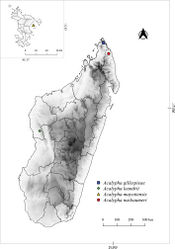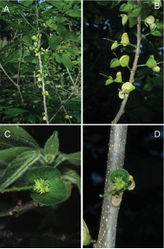Acalypha mayottensis
| Notice: | This page is derived from the original publication listed below, whose author(s) should always be credited. Further contributors may edit and improve the content of this page and, consequently, need to be credited as well (see page history). Any assessment of factual correctness requires a careful review of the original article as well as of subsequent contributions.
If you are uncertain whether your planned contribution is correct or not, we suggest that you use the associated discussion page instead of editing the page directly. This page should be cited as follows (rationale):
Citation formats to copy and paste
BibTeX: @article{Montero-Muñoz2020PhytoKeys140, RIS/ Endnote: TY - JOUR Wikipedia/ Citizendium: <ref name="Montero-Muñoz2020PhytoKeys140">{{Citation See also the citation download page at the journal. |
Ordo: Malpighiales
Familia: Euphorbiaceae
Genus: Acalypha
Name
Acalypha mayottensis I.Montero & Cardiel sp. nov. – Wikispecies link – Pensoft Profile
Diagnosis
Acalypha mayottensis I.Montero & Cardiel is morphologically similar to A. humbertii Leandri, but differs from it mainly by having ovoid axillary buds with imbricate perules (vs. pyriform buds with superposed perules), triangular-lanceolate stipules c. 6 mm long (vs. linear stipules c. 3 mm long), and mature female bracts to 19 × 21 mm with crenate to subentire margins (vs. bracts to 6 × 8 mm with dentate margins).
Type
Mayotte. Mamoudzou commune: Îlot M’bouzi, 12°48'50"S, 45°14'08"E, 10–50 m, 22 Nov 2000, J.-N. Labat, F. Barthelat, C.M. Hladik & A.B. Sifary 3268. (holotype: G [G00034240!]; isotypes: K!, MAO, MO [MO-2965774!], P [P00209719!]). Figs 4, 5.
Description
Shrubs to 5 m high, deciduous, monoecious. Young branches laxly pubescent, with simple, erect trichomes c. 1 mm long; Older branches glabrous. Axillary buds ovoid, c. 3 × 2.3 mm, perules 2, imbricate, blackish, chartaceous, glabrous. Stipules caducous, c. 6 mm long, linear to triangular-lanceolate, becoming filiform when mature, sparsely hairy, glabrescent, margins translucent, with some glands. Petioles slender, (2–) 3–5 (–6) cm long, pubescent with simple, antrorsely curved, trichomes. Leaf blades 5–10 × 3–6 cm, ovate-lanceolate to elliptic-lanceolate, membranous; base rounded to subcordate; margins crenate-serrate to subentire, slightly revolute, teeth minute, rounded, sinuses ciliate; apex subacuminate to acuminate, acumen c. 1.5 cm long, rounded; upper surface pubescent with simple, thin, patent, trichomes, glabrescent; lower surface with indumentum similar to that found on upper surface, but more dense; axils of the secondary veins with minute, sparsely hairy, pocket-shaped domatia, sometimes only hair-tuft domatia; venation actinodromous, with 3 veins at the base, secondary veins 4–6 per side. Stipels absent. Inflorescences androgynous, axillary, to 6 cm long, spiciform, with 1–2 female bracts near the base and a male segment distally; peduncle thick, c. 1.5 cm long, laxly pubescent, trichomes similar to those found on the young branches, glabrescent; male segment c. 4 cm long. Female bracts sessile, enlarging in fruit to 19 × 21 mm, subreniform, sparsely hairy with simple, erect trichomes c. 1.5 mm long on veins and margins, glabrescent; margins crenate to subentire, sometimes dentate in young bracts. Male flowers inconspicuous, pedicel c. 1 mm long, glabrous; buds c. 0.7 mm diameter, sparsely hairy, with arachnoid trichomes. Female flowers solitary, sessile; sepals 3[4], connate at base, c. 0.7 mm long, ovate-triangular, sparsely hairy with simple, arachnoid trichomes; ovary 3-locular, c. 1 mm diameter, echinate and hispid; styles 3, c. 3 mm long, free at the base, rachis thick, appressed-pubescent, each divided into 8–10 segments. Capsules to 4 mm diameter, echinate and hispid, with simple, erect trichomes c. 1 mm long, and conical projections c. 1 mm long, subacute. Seeds pyriform, 2.5 × 2 mm, minutely foveolate.
Distribution and habitat
Acalypha mayottensis is endemic to Mayotte, a French overseas department in the Comoros Archipelago, and presumably restricted to the Mbouzi islet (Fig. 2). Mbouzi is a small, volcanic, unoccupied islet, of 82 ha, located east of the main island (Grande-Terre). It has a tropical humid climate, with two seasons: one cool and dry, the other hot and wet, resulting from shifts in the Intertropical Convergence Zone. Mbouzi is mainly covered by secondary dry deciduous forest (Boullet and Traclet 2018[1]). According to the specimens’ labels, A. mayottensis is a common deciduous bush on the islet, growing in deciduous forest, in ravines and stony areas, from 10 to 90 m elevation.
Etymology
The proposed epithet refers to Mayotte island, to which the small Mbouzi islet belongs.
Conservation status
Acalypha mayottensis is only known from Mbouzi islet. The extent of occurrence (EOO) is estimated to be 0.017 km2. Its area of occupancy (AOO) is estimated to be 8 km2. Mbouzi islet was declared a “Réserve Naturelle Nationale” in 2007, a category IV protected area (Dudley 2008[2]). In the 1990s the islet had lost 70% of its original forests due to agricultural activities. Mbouzi currently conserves 10% of its natural and subnatural forest (Boullet and Traclet 2018[1]). Currently, the most serious threat is invasive species, both animals, such as Eulemur fulvus, and plants, such as Antigonon leptopus, Lantana strigocamara, Leucaena leucocephala, Litsea glutinosa, Spathodea campanulata and Furcraea foetida (Boullet and Traclet 2018[1], Quintard et al. 2019[3]). A. mayottensis is assigned a preliminary IUCN conservation status of Critically Endangered: CR B1ab(i,iii) + B2ab(ii,iii).
Additional specimen examined
(paratypes). Mayotte. Mamoudzou commune: Îlot M’Bouzi, 12°48'57"S, 45°14'06"E, 90 m, 22 Nov 2000, J.-N. Labat, F. Barthelat, C.M. Hladik & A.B. Sifary 3272 (G [G00034255!], K!, MAO, MO [MO-2966248!], P [P00209724!, P00209725!]); Îlot M’Bouzi, 12°48'39"S, 45°14'06"E, 26 Dec 2002, F. Barthelat, A. de Vanssay & G. Rembert 1112 (MAO, P [P00339165!]); precise location unknown, probably from M’Bouzi islet, 01 Jan 2010, G. Viscardi 310 (HKM, P [P02439826!]).
Notes
Five other species of Acalypha are known from Mayotte: Acalypha chibomboa Baill., A. indica L., A. lanceolata (Müll.Arg.) Radcl.-Sm., A. paxii Aug.D.C., and A. richardiana Baill. A. mayottensis does not strongly resemble any of them. The only other Acalypha species known from Mbouzi islet is A. richardiana, which differs mainly by having sessile androgynous inflorescences and mature female bracts subrounded, c. 7 × 6 mm (vs. pedunculate androgynous inflorescences and mature female bracts subreniform, c. 19 × 21 mm in A. mayottensis). The herbarium specimens of A. mayottensis had been previously identified as A. claoxyloides Hutch., endemic to the Seychelles Archipelago, but it clearly differs by having flattened resinous glands on lower leaf surface, female bracts and flowers, and smooth capsules (vs. resinous glands absent and echinate capsules in A. mayottensis).
Original Description
- Montero-Muñoz, I; Levin, G; Cardiel, J; 2020: Four new species of Acalypha L. (Euphorbiaceae, Acalyphoideae) from the West Indian Ocean Region PhytoKeys, 140: 57-73. doi
Images
|
Other References
- ↑ 1.0 1.1 1.2 Boullet V, Traclet S (2018) Analyse et cartographies des végétations de la Réserve naturelle nationale de l’îlot Mbouzi (Mayotte). Rapport technique non publié, Conservatoire Botanique National de Mascarin, 1–150. [106 pp. annexes]
- ↑ Dudley N (2008) Guidelines for Applying Protected Area Management Categories.Gland, Switzerland, IUCN, 86 pp. https://doi.org/10.2305/IUCN.CH.2008.PAPS.2.en
- ↑ Quintard B, Lefaux B, Lécu A, Niphuis H, Roux P, Ortiz K (2019) Biomedical evaluation of a brown lemur (Eulemur fulvus spp.) population from Mbouzi islet, Mayotte island.Journal of Zoo and Wildlife Medicine50(3): 650–658. https://doi.org/10.1638/2017-0240


